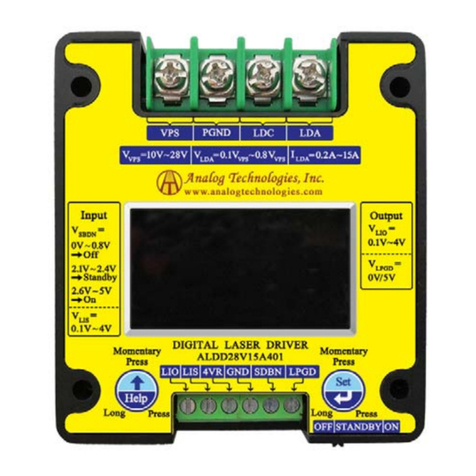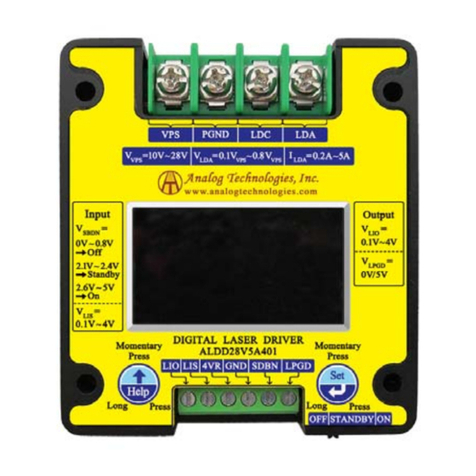
1161 Ringwood Ct, #110, San Jose, CA 95131, U. S. A. Tel.: (408) 748-9100, Fax: (408) 770-9187 www.analogtechnologies.com
nalog Technologies ATLS1A102
Low Noise Constant Current Laser Driver
power supply 0V
Power Supply 5V
D1
Laser Diode
(Optional)
LISH
6
LPGD 12
VPS 10
LDC 7
PGND 9
GND
2
P5V
5
SYNC 11
LDA 8
2P5V
3
LISL
4
SDN
1
Sync. Signal
DAC
MC MC
Figure 4. A Typical Micro-processor-based Application
In this circuit, the input current can be set by a DAC (Digital
to Analog Converter). By sensing the logic level of LPGD,
pin 12, the working status of the controller can be monitored
by a micro-controller (MC), when it is logic “1”, the loop is
good; “0”, the loop is at fault, which includes open circuit at
the laser diode connections, or short circuit from LDA to
ground, but excludes short circuit at the laser diode and
short circuit from LDC to ground. Shut down pin can also
be controlled by the micro-controller, setting it to logic “1”
turns on the controller, “0” turns it off. Please notice that
this pin comes with an internal pull up resistor of 100k, it
can be ORed (logic OR) by multiple digital ports of several
micro-controllers, with each of the port having an open-
drain output. The internal voltage reference output, 2P5V,
pin 3, can be used as the reference voltage for the ADCs and
the DACs.
The output current is set by adjusting W1, which sets input
voltages of LISL (Laser I (current) Set Low-speed), pin 4.
The output current will be:
IOUT (A) = VLISL (V)/2.5 (V).
LISL should never be left float. Otherwise, the output
current will go too high a value that the laser might be
damaged.
The LISL pin allows modulating the output current at a
speed of up to 0.08Hz. This low speed port filters out high
frequency noise, if any, in the input signal applied to this pin.
In addition to using the LPGD pin for monitoring the
working status of the controller, the output current can be
monitored directly by measuring the voltage of LIS pin. The
equation is:
IOUT = VLIS (V)/2.5 (V).
For example, when seeing LIS = 2.5V, the output current is
2.5V/2.5V = 1A.
MODULATING OUTPUT CURRENT
When low speed current modulation is needed, connect
LISL pin to the modulation signal. As LISL changes from 0
to 2.5V, the output current changes from 0 to 1A linearly.
The rise and fall time achieved by modulating LISL is about
4 seconds and the equivalent bandwidth is about 0.1Hz. The
advantage of using LISL as the modulation signal input port is
that the output current noise will not increase. The
disadvantage is that the speed is not high.
The LISL pin can be set by a POT, DAC, or a PWM signal
directly from a micro-controller. Please notice that when using
a PWM signal for setting the current voltage LISL, a low pass
filter will not be needed, since there is an internal low pass
filter.
It is recommended not to set the LISL pin to 0V, but keep
it >0.05V at all the time. The reason is that the laser diode
usually has a junction voltage of 2.5V, when setting the LISL
pin voltage to 0V, the output voltage will warble between 0V
and 2.5V, cause some oscillation slightly.
When high speed current modulation is needed, feed the
modulation signal to LISH (no need to connect LISH to P5V
pin). As LISH change from 0 to 0.5V, the output current
changes from 0 to 1A linearly. The fall and rise time is about
1μS, and the full power bandwidth is about 300kHz. Using
LISH pin as the modulation signal input port results in high
speed modulation, however, the noise from the modulation
signal source will be converted into output current noise.
The switch can be any analog switch, but having low leakage
current.
OUTPUT CURRENT MONITORING
The output current can be monitored in real time by measuring
the voltage on the LIS pin. When LPGD (loop good) pin is
high,
IOUT = VLIS (V)/2.5 (V).
For example, when seeing the LIS pin has a voltage of 2.5V,
the output current = 2.5V/2.5V = 1A.
Use a high input impedance voltage meter or DAC to monitor
the output current, such as >5k. Otherwise, some error will be
introduced at the output current. When the impedance is 5k, the
current error caused at the output is about 0.01%.
Please be aware that adding capacitor on this pin will increase
the high frequency noise current. Therefore, when monitoring
the output current on this pin continuously, insert a resistor of
about >5k in series with the voltage meter or ADC. In this way,
there is no big capacitance added on the LDC pin.
Under no-fault operation conditions, the output voltage of LDC
is always the same as that of LISH.
POWER UP PROCEDURE
Laser diode is a vulnerable device. Special cautions must be
taken for turning on the controller. These are the
recommendations:
1. Hold the SDN pin to ground by a mechanical switch or an
electronic logic device when turning on the power on the
VPS pin and release the SDN pin to logic high after the
LIO ADC

























